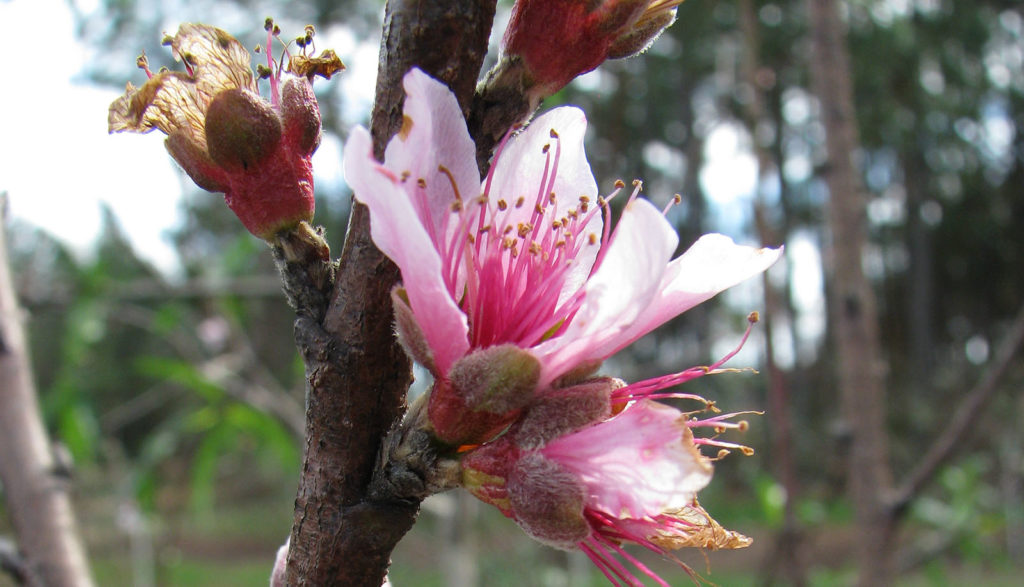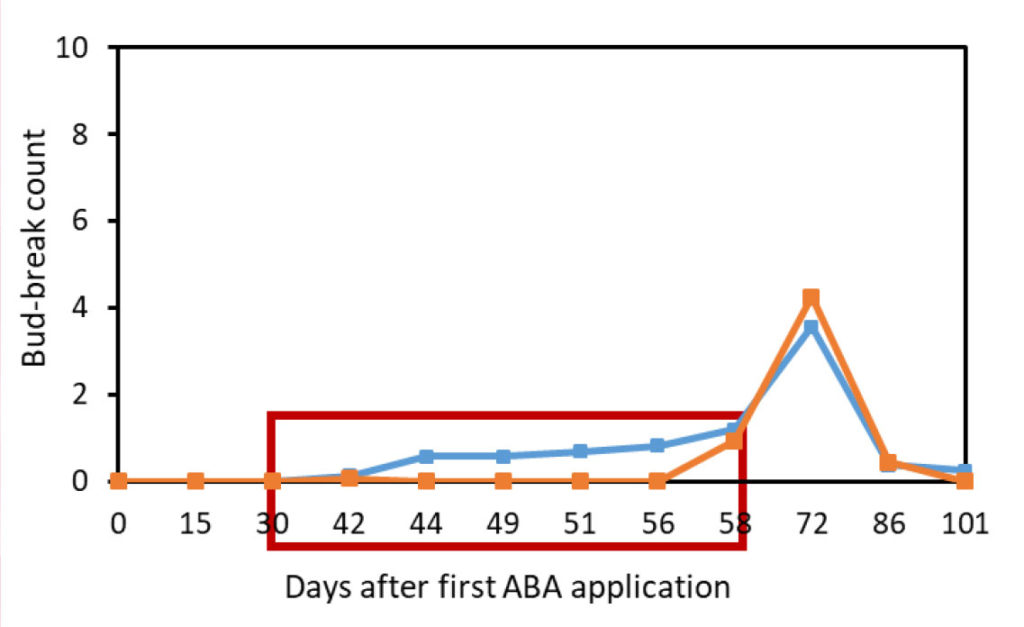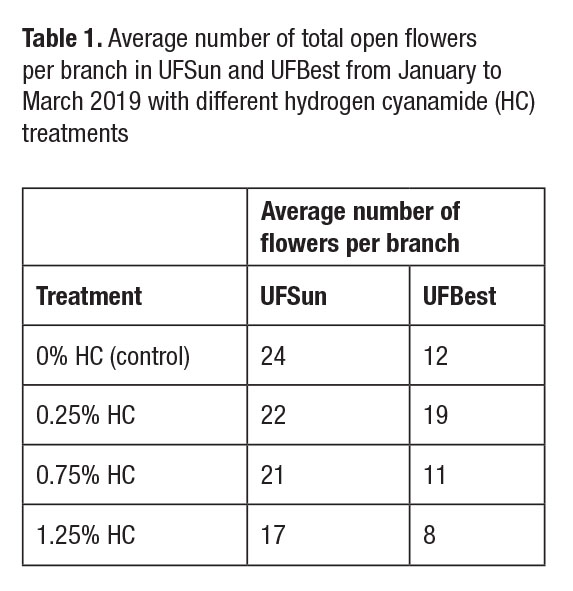
By Tripti Vashisth
Unlike citrus, peaches are deciduous fruit trees. Deciduous trees shed their leaves during the late fall and early winter and undergo dormancy. During this dormant stage, a certain amount of cold weather (measured by an accumulation of chill units) is needed to resume normal growth in the spring. When the cold weather requirement for dormancy is fulfilled, the warm spring weather ends the resting period and results in bud break (vegetative and floral).

The requirement for chill-hour accumulation depends on the cultivar. For example, most of the varieties grown in South Carolina require more than 800 chill units, whereas the varieties that are bred for Central Florida require 100 chill units or less. Peach varieties that do not accumulate sufficient chill units result in poor or uneven bud break, sporadic flowering, delayed leaf emergence and poor fruit set.
Mild winters and fluctuating temperatures in the fall continue to be one of the biggest challenges for Florida peach production. Not only is uniform bud break a concern, but with mild winter temperatures, onset of dormancy can be a challenge. As a result, it is quite common to see peach trees flowering in September or October in Central Florida (Figure 1). Such off-season flowering is a problem because the resulting fruit set is of low quality, prone to freeze injury and can cause production challenges. In a nutshell, both entering and breaking dormancy is a challenge for peaches grown under mild winter conditions.
HYDROGEN CYANAMIDE
Currently, Florida peach growers have an effective tool, hydrogen cyanamide (HC), to induce uniform bud break. HC, sold under brand names Dormex and BudPro, is a plant growth regulator used worldwide in fruit crops to induce bud break under mild and inconsistent winter conditions. When sprayed on defoliated trees, HC can result in advanced and uniform bud break.

Previous research in North Florida has shown that when HC is sprayed at rates between 1% to 1.5%, it can result in bud-break advancement by five to six weeks in peaches and blueberries. Compared to untreated trees, Tropic Beauty peaches that received an HC application at 1.2% active ingredient in the third week of December resulted in a six-week advancement as well as synchronized floral and vegetative bud break. The fruit from HC-treated trees ripened uniformly and were of marketable quality.
Interestingly, the same HC treatment in Central Florida conditions advanced the bud break by only two weeks. Therefore, it is critical to time the anticipated bud break correctly with the geographic location. The number of chill hours accumulated and temperature for the next several days play a significant role in tree response to HC application. An early bud break can be susceptible to freeze injury, whereas a late application of HC may not be beneficial.
HC works best when a certain number of chill units have already accumulated. However, if applied after bud swell, phytotoxicity can occur that damages flower buds and reduces potential fruit set. HC results in bud break through imposing oxidative stress in the buds, resulting in activity of dormant buds. Phytotoxicity causes buds that are already at the swollen stage to burn due to oxidative stress burst.
To address this situation, University of Florida Institute of Food and Agricultural Sciences (UF/IFAS) researchers conducted a study to evaluate efficacy of HC at a lower rate. The rationale was that a lower HC rate may effectively induce bud break but may not cause phytotoxic responses to advanced buds.
In the cultivars UFBest and UFSun, the lower rates of HC (0.25% and 0.75%) were effective in inducing bud break similar to the 1.25% HC treatment. In HC-treated UFBest, bud break was uniform, synchronized and advanced by two weeks, as compared to the control. In UFSun, all three HC treatments caused the bud break to be uniform, compact and synchronized as compared to the control.
The lower HC treatments (0.25% and 0.75%) resulted in the same number of flowers as compared to the control. However, 1.25% HC resulted in a lesser number of flowers, suggesting the HC phytotoxicity caused bud abscission (Table 1).
ABSCISIC ACID
To address dormancy onset issues, research has evaluated abscisic acid (ABA), a plant growth regulator. The accumulation of endogenous ABA starts with onset of winter and increases with increased depth of dormancy. Literature suggests exogenous application of ABA causes leaf abscission, enhances bud-growth inhibition and reduces off-season as well as prolonged bud break and flowering in grapevines.
Two foliar ABA applications made in November in Central Florida successfully suppressed off-season peach flowering (Figure 2). In addition, when ABA was used in combination with HC, synchronized flowering was observed. These results are promising, suggesting that ABA and HC can be used to improve the flowering situation in Florida conditions. However, currently ABA is not labeled for peach use. Nonetheless, as researchers continue to explore ABA, growers are encouraged to continue maintaining the foliage on trees going into fall. Generally, off-flowering becomes widespread only after the leaf drop begins in the fall.
SUMMARY
HC is a readily available tool for Florida peach growers to induce uniform bud break. Bud-break advancement by HC is dependent on geographic location and requires careful consideration. In Central Florida conditions, a lower rate of HC (0.75%) is as effective as 1.25% (most popular rate) HC for uniform and advanced bud break. With a lower rate of HC, the cost of application can be reduced with minimal to no phytotoxic response on the peach tree, thereby increasing the profit margin.
The response of a peach tree to HC is cultivar and location specific. Therefore, it is highly recommended for growers to test HC application in pilot scale before applying it to large acreage.
Tripti Vashisth is an assistant professor at the UF/IFAS Citrus Research and Education Center in Lake Alfred.









